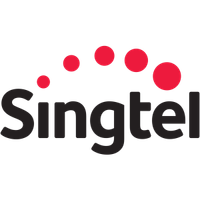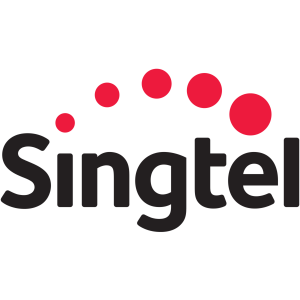
Singapore Telecommunications Ltd
SGX:Z74


| US |

|
Johnson & Johnson
NYSE:JNJ
|
Pharmaceuticals
|
| US |

|
Berkshire Hathaway Inc
NYSE:BRK.A
|
Financial Services
|
| US |

|
Bank of America Corp
NYSE:BAC
|
Banking
|
| US |

|
Mastercard Inc
NYSE:MA
|
Technology
|
| US |

|
UnitedHealth Group Inc
NYSE:UNH
|
Health Care
|
| US |

|
Exxon Mobil Corp
NYSE:XOM
|
Energy
|
| US |

|
Pfizer Inc
NYSE:PFE
|
Pharmaceuticals
|
| US |

|
Palantir Technologies Inc
NYSE:PLTR
|
Technology
|
| US |

|
Nike Inc
NYSE:NKE
|
Textiles, Apparel & Luxury Goods
|
| US |

|
Visa Inc
NYSE:V
|
Technology
|
| CN |

|
Alibaba Group Holding Ltd
NYSE:BABA
|
Retail
|
| US |

|
3M Co
NYSE:MMM
|
Industrial Conglomerates
|
| US |

|
JPMorgan Chase & Co
NYSE:JPM
|
Banking
|
| US |

|
Coca-Cola Co
NYSE:KO
|
Beverages
|
| US |

|
Walmart Inc
NYSE:WMT
|
Retail
|
| US |

|
Verizon Communications Inc
NYSE:VZ
|
Telecommunication
|
Utilize notes to systematically review your investment decisions. By reflecting on past outcomes, you can discern effective strategies and identify those that underperformed. This continuous feedback loop enables you to adapt and refine your approach, optimizing for future success.
Each note serves as a learning point, offering insights into your decision-making processes. Over time, you'll accumulate a personalized database of knowledge, enhancing your ability to make informed decisions quickly and effectively.
With a comprehensive record of your investment history at your fingertips, you can compare current opportunities against past experiences. This not only bolsters your confidence but also ensures that each decision is grounded in a well-documented rationale.
Do you really want to delete this note?
This action cannot be undone.

| 52 Week Range |
2.31
3.4
|
| Price Target |
|
We'll email you a reminder when the closing price reaches SGD.
Choose the stock you wish to monitor with a price alert.

|
Johnson & Johnson
NYSE:JNJ
|
US |

|
Berkshire Hathaway Inc
NYSE:BRK.A
|
US |

|
Bank of America Corp
NYSE:BAC
|
US |

|
Mastercard Inc
NYSE:MA
|
US |

|
UnitedHealth Group Inc
NYSE:UNH
|
US |

|
Exxon Mobil Corp
NYSE:XOM
|
US |

|
Pfizer Inc
NYSE:PFE
|
US |

|
Palantir Technologies Inc
NYSE:PLTR
|
US |

|
Nike Inc
NYSE:NKE
|
US |

|
Visa Inc
NYSE:V
|
US |

|
Alibaba Group Holding Ltd
NYSE:BABA
|
CN |

|
3M Co
NYSE:MMM
|
US |

|
JPMorgan Chase & Co
NYSE:JPM
|
US |

|
Coca-Cola Co
NYSE:KO
|
US |

|
Walmart Inc
NYSE:WMT
|
US |

|
Verizon Communications Inc
NYSE:VZ
|
US |
This alert will be permanently deleted.
 Singapore Telecommunications Ltd
Singapore Telecommunications Ltd





























 You don't have any saved screeners yet
You don't have any saved screeners yet

Thank you for joining us for SingTel's results for the third quarter and 9 months ended 31st December 2017.
Group revenue and EBITDA rose 4% and 6% respectively, with strong contributions from Consumer Australia and Amobee. Optus added 127,000 mobile customers, its highest quarterly growth in postpaid customers. Amobee continued to scale and delivered positive EBITDA for the second consecutive quarter.
Our additional strategy is paying off. In the core business, adoption of new technology and processes helped improve customer experience and reduce costs. We also built new capabilities, expanded into new businesses and successfully diversified our revenue streams. During the quarter, 23% of the group's revenue came from digital and ICT services.
The regional associates' contribution fell 18%, with intense price competition in India and higher depreciation and amortization charges. Underlying net profit was 8% lower on declining voice revenues as well as higher network depreciation and spectrum amortization charges from increased infrastructure investments. Free cash flow rose on strong operating cash flow and higher dividend receipts.
The weaker Australian dollar, Indonesian rupiah and Philippine peso reduced underlying net profit for the quarter by SGD 19 million or 2%. Over the 9 months period, foreign currency movements had minimal impact on the group's underlying net profit.
We are the first telco in Asia Pacific to achieve speeds exceeding 1Gbps in a wireless trial. This paves the way for commercial deployment in high-traffic locations. We continue to differentiate ourselves with exclusive handset launches, including the latest Google Pixel 2 XL and the gaming-centric Razer Phone. Optus' network has been named Australia's Best in Test in the P3 connect Mobile Benchmarking test. We continue to future-proof our network and in December, acquired new metropolitan licenses in the 2300 and 3500 megahertz spectrum bands, positioning Optus strongly in the race towards 5G. The SingTel Group of companies and Mobike formed a strategic partnership to explore IoT, mobile payments, data analytics and marketing. Through this collaboration, we will leverage our combined scale and capabilities to create new business opportunities.
In the enterprise space, we formed important partnerships to develop talent and build capabilities in emerging digital technologies. Together with A*STAR, NRF and NTU, we are spearheading R&D in artificial intelligence, advanced data analytics, robotics and IoT, including the setting up of a SGD 42 million corporate laboratory. In Australia, Optus Business pledged investments to the Cyber Security Cooperative Research Centre to advance Australia's cyber defenses and capabilities. In digital marketing, the integration of Turn has realized synergies and helped Amobee win customers across the U.S. and Asia Pacific.
Let me share the progress we made in digitizing the customer experience. Engaging customers through apps and online remains a key focus for us. Usage of My Singtel and My Optus apps has grown rapidly. Over 3 million customers now use them regularly for a wide range of services, including subscription of data roaming plans, prepaid recharge, monitoring data usage and bill payments.
Online sales currently account for 20% and 17% of all sales in Singapore and Australia respectively, and more than half of customer care transactions are done on a self-help basis. In the last 2 quarters, the proportion of assisted transactions in Australia have risen, reflecting the accelerated NBN rollout. Customers growing acceptance of online channels has allowed us to respond to an increasing volume of transactions in a faster and more efficient manner.
For the 9 months, net profit included exceptional gains of SGD 2 billion from the divestment of NetLink Trust in July 2017. Underlying net profit declined 5% from Airtel's lower contributions as well as higher depreciation and amortization charges. Excluding Airtel's results, underlying net profit would have been stable.
The group's financial position remains strong. Free cash flow for the 9 months rose 23% as favorable working capital movements in Australia and higher dividends from associates offset higher capital expenditure. Strong cash flow generation and proceeds from the divestment of NetLink Trust resulted in lower net debt. Average maturity of borrowings was approximately 4 years.
Singapore consumer revenues declined 6% on lower voice and equipment revenues. Mobile communications revenue was impacted by an increased mix of customers switching to SIM Only plans. Around 15% of new and recontracting postpaid customers signed up for SIM Only plans during the quarter. Growth in mobile data partially offset the erosion in voice. Higher takeup of data-roaming packages also helped moderate the declines in roaming revenues. Consumer home revenues declined mainly due to the cessation of Premier League sublicensing, while growth in broadband offset lower fixed voice usage. Equipment sales decreased due to delays in the launches of popular handsets and higher takeup of SIM Only plans. The effects of lower voice usage and the cessation of Premier League sublicensing revenues led to a 9% decline in EBITDA.
In Australia, revenue rose 8%, with strong growth in postpaid mobile and NBN customers as well as higher NBN migration payments. Mobile service revenue increased 4%, underpinned by a record 125,000 new postpaid handset customers. Postpaid ARPU continues to be impacted by an increasing mix of SIM Only plans as well as higher DRP credits, with greater mix of higher-value handset plans. In the prepaid segment, prepaid customer base declined by 29,000, with Optus' focus on acquiring quality customers.
Mass market fixed revenues were up 21%, with solid growth in NBN customers and migration revenues. EBITDA increased 15% on service revenue growth and disputes settlement. In November, NBN Co. announced that it will delay the rollout of HFC connections by 6 to 9 months. As a result, Optus expects that its NBN customer growth will moderate and revenue from migration payments will decline from prevailing levels.
Our regional associates continued to register strong customer growth and increasing data consumption. However, intense competition in India and higher depreciation and amortization charges led to an 18% decline in associates' profits. Excluding Airtel, associates' earnings declined 2%. In Indonesia, telecom sales earnings were impacted by heightened competition in data and declines in traditional voice services. Airtel's results were adversely impacted by the cut in domestic mobile termination rates and intense price competition. It sold a 4.5% stake in Bharti Infratel, with proceeds used for deleveraging. In Africa, Airtel continued its positive growth momentum, delivering top line and margin growth and a fourth consecutive quarter of profits.
Airtel continued its portfolio rationalization and received regulatory approval for the acquisition of Tigo Rwanda. In Thailand, AIS registered robust earnings growth of 35%, led by revenue growth and strong cost management. In the Philippines, Globe earnings declined 32% due to higher depreciation and finance costs on network investments.
In group enterprise, cybersecurity services grew 6% as we continue to invest and build cyber capabilities. Leveraging our expanding network footprint in Australia, Optus Business posted strong growth in mobile revenue and record customer net additions. Overall, revenue declined mainly due to phasing of projects and one-off product sales last year as well as price erosion in traditional carriage services. Notwithstanding the decline in revenue, group enterprise remains the market leader in Asia Pacific for telco and ICT services. EBITDA was stable and improved margins from ICT project efficiencies and tighter cost controls.
GDL's businesses continue to gain scale, but HOOQ widened its EBITDA losses due to continued investments in content and technology. Amobee made significant progress towards profitability, delivering robust revenue growth and positive EBITDA. Today, Amobee owns one of the world's strongest demand-side platforms, with an ability to process more than 6 million advertisements per second, augmented by advanced analytics and an extensive ecosystem of partners. It also reaffirms its industry leadership with multiple awards, recognizing its excellence in mobile marketing campaigns.
HOOQ expanded its content suite by securing exclusive rights to the latest Hollywood content and the Philippine local content through partnerships. The group is affirming its guidance for the financial year.
And this concludes my presentation for the quarter. Thank you.